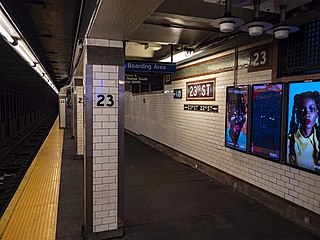
The 23rd Street station is a local station on the IRT Lexington Avenue Line of the New York City Subway. Located at the intersection of Park Avenue South and 23rd Street in Gramercy Park and Flatiron District, Manhattan, it is served by 6 trains at all times, <6> trains during weekdays in the peak direction, and 4 trains during late night hours.

23rd Street is a broad thoroughfare in the New York City borough of Manhattan, one of the major two-way, east-west streets in the borough's grid. As with Manhattan's other "crosstown" streets, it is divided into its east and west sections at Fifth Avenue. The street runs from Avenue C and FDR Drive in the east to Eleventh Avenue in the west.

Rowland Hussey Macy Sr. was an American businessman who founded the department store chain Macy's.
The Lenox Avenue Line is a line of the New York City Subway, part of the A Division, mostly built as part of the first subway line. Located in Manhattan, New York City, it consists of six stations between Central Park North–110th Street and Harlem–148th Street, all of which are situated within the neighborhood of Harlem in Upper Manhattan.

Madison Square is a public square formed by the intersection of Fifth Avenue and Broadway at 23rd Street in the New York City borough of Manhattan. The square was named for Founding Father James Madison, fourth President of the United States. The focus of the square is Madison Square Park, a 6.2-acre (2.5-hectare) public park, which is bounded on the east by Madison Avenue ; on the south by 23rd Street; on the north by 26th Street; and on the west by Fifth Avenue and Broadway as they cross.
L. S. Ayres and Company was a department store based in Indianapolis, Indiana, and founded in 1872 by Lyman S. Ayres. Over the years its Indianapolis flagship store, which opened in 1905 and was later enlarged, became known for its women's fashions, the Tea Room, holiday events and displays, and the basement budget store. As urban populations shifted to the suburbs, Ayres established branch stores in new shopping centers in several Indiana cities. Ayres also acquired retail subsidiaries in Springfield, Illinois; Fort Wayne, Indiana; and Louisville, Kentucky. Ayr-Way, the Ayres discount store subsidiary, became the first discount store launched by a full-line department store. By the end of the 1960s Ayres had become a diversified merchandising business with retail department stores, a chain of discount stores, specialty clothing stores, a home furnishings showroom, and a real estate holding company. A long-time Ayres slogan, "That Ayres Look", promoted the company as a fashion leader, and by 1972 it had become the oldest continuous retail slogan in the United States.

The Central Park North–110th Street station is a station on the IRT Lenox Avenue Line of the New York City Subway, located at the intersection of 110th Street and Lenox Avenue at the southern edge of Harlem, Manhattan. It is served by the 2 and 3 trains at all times.

Clinton and Russell was a well-known architectural firm founded in 1894 in New York City, United States. The firm was responsible for several New York City buildings, including some in Lower Manhattan.

Macy's Herald Square is the flagship of Macy's department store, as well as the Macy's, Inc. corporate headquarters, on Herald Square in Manhattan, New York City. The building's 2.5 million square feet (230,000 m2), which includes 1.25 million square feet (116,000 m2) of retail space, makes it the largest department store in the United States and among the largest in the world. The store has an in-store jail, Room 140, where customers suspected of shoplifting are detained.

Starrett & van Vleck was an American architectural firm based in New York City which specialized in the design of department stores, primarily in the early 20th century. It was active from 1908 until at least the late 1950s.

The Ladies' Mile Historic District was a prime shopping district in Manhattan, New York City at the end of the 19th century, serving the well-to-do "carriage trade" of the city. It was designated in May 1989, by the New York City Landmark Preservation Commission to preserve an irregular district of 440 buildings on 28 blocks and parts of blocks, from roughly 15th Street to 24th Street and from Park Avenue South to west of the Avenue of the Americas. Community groups such as the Drive to Protect the Ladies' Mile District and the Historic Districts Council campaigned heavily for the status.

The W New York Union Square is a 270-room, 21-story boutique hotel operated by W Hotels at the northeast corner of Park Avenue South and 17th Street, across from Union Square in Manhattan, New York. Originally known as the Germania Life Insurance Company Building, it was designed by Albert D'Oench and Joseph W. Yost and built in 1911 in the Beaux-Arts style.
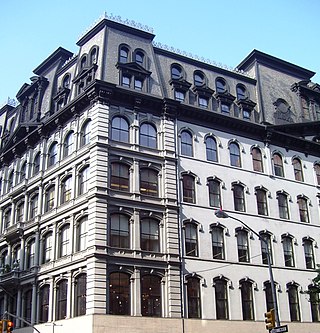
Arnold Constable & Company was a department store chain in the New York City metropolitan area. At one point it was the oldest department store in America, operating for over 150 years from its founding in 1825 to its closing in 1975. At the company's peak, its flagship "Palace of Trade" in Manhattan – located at 881-887 Broadway at East 19th Street, through to 115 Fifth Avenue – was acknowledged to be the store which took the largest portion of the "carriage trade", in New York, serving the rich and elite of the city, such as the wives of Grover Cleveland, Andrew Carnegie, Thomas Edison, J.P. Morgan, John D. Rockefeller and Cornelius Vanderbilt.

462 Broadway (also known as the Mills & Gibb Building, 120-132 Grand Street and 30 Crosby Street) is a commercial building on Broadway between Crosby and Grand Streets in the SoHo neighborhood of Lower Manhattan, New York City Featuring polished red granite on the ground floor, it was built of cast iron in the French Renaissance style in 1879-1880 to a design by John Correja.

Philo Laos Mills was the cofounder of the dry good house, Mills & Gibb. He had been partners with John Gibb for over 40 years. As a young man, he entered the employ of E. S. Jafiray & Company, and after several promotions, became buyer for the lace department. In 1865, with Gibb, he formed the firm of Mills & Gibb, incorporating in 1903. Mills then moved to England, became a British subject and took charge of all the foreign business of the concern. He resided in Ruddington and served as High Sheriff of Nottinghamshire in 1897. His home at Ruddington Hall included a noted stock farm. A generous local benefactor, he bred prize-winning pedigree cattle, pigs and shire horses. An article appeared in Country Life, 1903 in praise of 'Livestock at Ruddington Hall'. Game birds, large white Yorksire pigs and rams were all kept at Home Farm in Landmere. Their fame led to buyers from Britain, Russia, Poland, Austria, Canada, Australia. He was President of the Nottingham Young Men's Christian Association. Although 73 years of age at the time of his death, he had been in excellent health. Mills, who was childless, was survived by his wife, who had greatly helped in his philanthropic work.
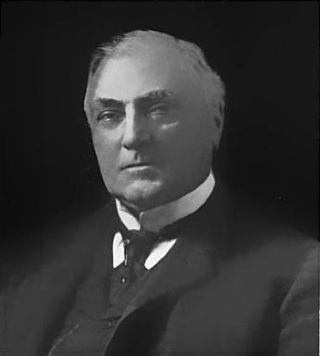
John Gibb was a cofounder of the dry goods house of Mills & Gibb.

300 Park Avenue South is a building on the northwest corner of East 22nd Street in the Flatiron District/Gramercy Park neighborhoods of Manhattan, New York City.
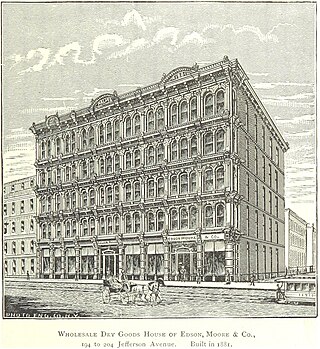
Edson, Moore & Co was a dry goods, importing and wholesale store started in 1872 in Detroit, Michigan by James L. Edson, Ransom Gillis, George F. Moore and special partner, Stephen Baldwin. The company was in operation from 1872 through 1974 when assets were sold.
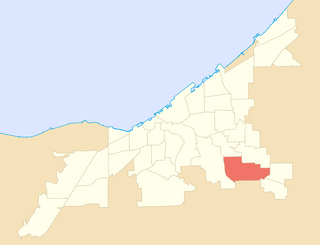
Union–Miles Park is a neighborhood on the Southeast side of Cleveland, Ohio, in the United States. The neighborhood draws its name from Union Avenue, and Miles Park in its far southwest corner.

The Trinity Building, designed by Francis H. Kimball and built in 1905, with an addition of 1907, and Kimball's United States Realty Building of 1907, located respectively at 111 and 115 Broadway in Manhattan's Financial District, are among the first Gothic-inspired skyscrapers in New York, and both are New York City designated landmarks. The Trinity Building, adjacent to the churchyard of Richard Upjohn's neo-Gothic Trinity Church, replaced an 1853 Upjohn structure of the same name. Earlier, the Van Cortlandt sugar house stood on the west end of the plot – a notorious British prison where American soldiers were held during the Revolutionary War.




















